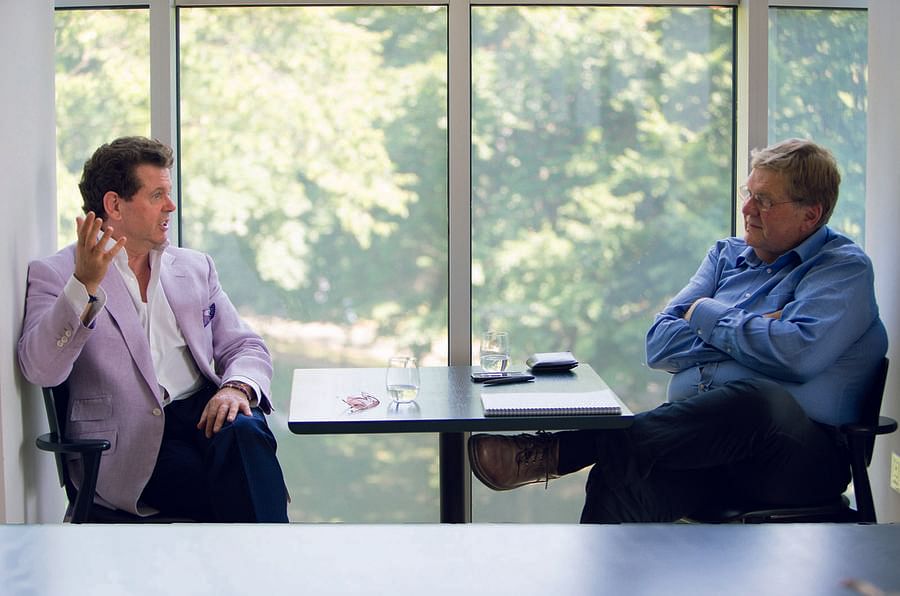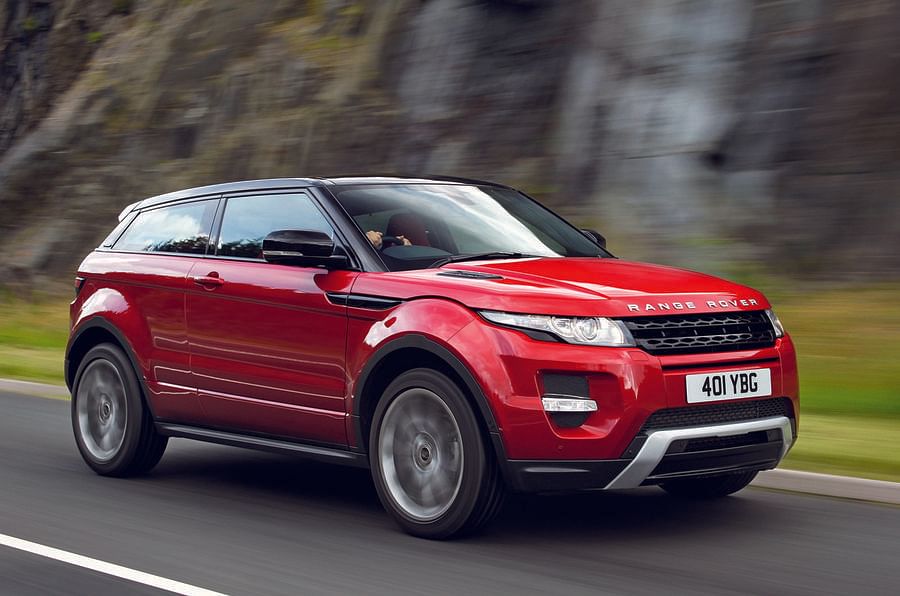Interview: Land Rover's design boss on the Range Rover Velar and brand's growth
The Range Rover Velar coupe-SUV has an India launch by end-2017. Designer Gerry McGovern's leadership has garnered a long line of design-savvy hits that have helped bring enviable sales growth to the brand.
One of the best things about Gerry McGovern, Land Rover design chief and architect of the new Range Rover Velar, is the way he confronts burning questions without a second’s hesitation.
We meet at London’s Design Museum, where a few months ago, with help from various random celebs, McGovern unveiled the latest Range Rover, the mid-sized Velar. He didn’t put it quite like this at the time, but there was a pervading feeling then – and it has persisted – that this was the McGovern team’s best work yet and the boss’s pride in it was obvious. Now we’re back because the museum in Kensington is close to his London home, and he feels very comfortable here.
It’s hot and McGovern has arrived late, piqued by a skirmish with a parking attendant. Under the circumstances, other interviewees would spend time tuning up, but within seconds, he’s deeply into the controversy that inevitably follows the launch of a full-capability 4x4 much more likely to ply London’s swankiest streets than the muddy hillsides that bred its forebears.

Gerry McGovern with Autocar UK's editor-in-chief Steve Cropley (right).
With his shameless and well-publicised interest in Savile Row suits, classic watches, challenging architecture and high-design furniture, and his even more outrageous decision to base his family in Chelsea rather than rural Warwickshire, where Jaguar Land Rover (JLR) is based, McGovern is already something of an antichrist for Land Rover traditionalists – or would be if his vehicles hadn’t inconveniently propelled Land Rover to seven successive annual sales leaps, the latest of which is an 8% expansion to 434,583 cars. With plenty of evidence on his side, McGovern gets very serious about defending his London connections.
“Being here helps me connect well with our customers,” he says. “I was in New Bond Street yesterday and there were Range Rovers everywhere. Seeing our customers and meeting some of them informs me about the standards they expect, especially the ones who are coming to the brand for the first time. We’re not just selling to car lovers. We’re dealing with customers who buy luxury in many forms – holidays, clothes, shoes, jewellery – and it has taken our business quite a long time to understand that. These people buy things that make them happy. Sure, they care about a Range Rover’s engineering, but for many, that’s the post-rationalisation bit.”
I ask whether it isn’t all too superficial. Doesn’t a dependance on such variable people risk running out of road? Won’t they move on to something else? McGovern instantly displays another of the qualities that has propelled him to the top: an instinct for certainty. “Not at all,” he insists. “I’ll tell you what’s in danger of running out of road: conventional automotive design, which is based on being different for the sake of it. What are the latest themes, they ask. What are the latest trends? Are we being different enough? Well, I’m not interested in that stuff. What should drive change is the way the world itself changes. How technology and materials change. Those are our opportunities and how we use them decides how successful we are.”

Which is where the Velar comes in. What might have been seen as a mere gap-plugger – after the Porsche Macan’s success drew attention to a yawning £45,000 to £70,000 price gap in the Land Rover range – was exultantly received around the world, even before a single road tester could slip behind the wheel. McGovern’s acknowledgement of this global good opinion is – for someone often accused of raging egotism – impressively restrained.
View the Range Rover Velar Image Gallery
“Our team did a good job,” he says. “What moves Velar on is its emphasis on modernity. Modernist doesn’t mean contemporary in the design sense. Modernism is a movement, a philosophy involving the use of simple forms. It’s about paring back, about not including things unless they absolutely have a job to do.
"Or several jobs. I haven’t seen a lot of that in recent car design, though some of the best classic cars have inadvertently embraced modernism because their designers created beautiful forms and left it at that.”
As the next question forms on my tongue, McGovern answers it: “And now you’ll ask me why we haven’t done this before. The truth is it wasn’t so easy here at Land Rover, where there has always been such passion about functionality. Because of that, it might have been easier for another brand to embrace these principles. But don’t get the idea I’m trying to undermine engineering. Without engineering and design working in partnership – me and Nick [Rogers, JLR’s engineering chief] having a very clear understanding – a project like Velar wouldn’t even get started.”
It stands massively to McGovern’s credit (and to that of his Jaguar opposite number, Ian Callum) that design has been elevated to the importance of engineering inside JLR’s Gaydon-Whitley estate. Both men have been tireless in explaining the significance of their discipline and have become ambassadors for the British design community in the process. But just to be safe, McGovern explains ‘why design matters’ one more time.
“Some people still think our job is to apply styling to an existing set of hard points. It was like that back in 2004, when I came back to Land Rover after my time with Lincoln in the US. Go away and make it look good, they’d say. But if you’re forced to do it that way, the horse has already bolted. Hard points define volumes and proportions, and together they’re the number one requisite for a great-looking vehicle. Get them wrong and it’ll never look any good, however good your details and surfaces. That’s why designers need to be involved in these decisions.”
Everything changed, says McGovern, with Tata Motors' acquisition of Jaguar and Land Rover for £1.3 billion in 2008. “There was lots of mumbling, both in Europe and India, about Tata buying us. Everyone asked the same question: what do they know? But then Mr [Ratan] Tata arrived and asked the killer question: why does design report to engineering? He’d trained as an architect, he loved cars and knew exactly what our job entailed. I won’t interfere, he told us, and no one else will. It’s your destiny and you control it.”

It was the 2011 Range Rover Evoque, McGovern says, that first demonstrated the baked-in desirability an emotive design could bring to a Land Rover. “It was a vehicle with design at its very core,” he says. “It’s not perfect, mind. The front overhang isn’t as good as I wanted it to be. But it has worked, for sure. Early on, someone in marketing told me we’d struggle to sell 30,000 a year, and then we did 130,000. I haven’t seen him around much lately...” In all this talk of hard points no longer being imposed, I feel rather rude suggesting that since Jaguar’s F-Pace SUV and the Range Rover Velar have much in common under the skin – and since the F-Pace appeared first – perhaps this is exactly what has happened with Land Rover’s latest and greatest. McGovern briskly bats this away, probably because he has right on his side. (I later hear, elsewhere in JLR, that the F-Pace preceded the Velar mostly because Jaguar’s need of an SUV sales bounce was greater.)
“We specified what we wanted,” says McGovern. “We’d had a mid-sized Range Rover planned for a long time, but it takes a time to fit new models into the cycle plan. We certainly didn’t use the same hard points as the F-Pace. We’d dictated our requirements well before that came along. The platform was created to provide what we needed and it worked for Jaguar, too.”
All of which focuses the mind on how the famously feisty McGovern and Jaguar’s more emollient Callum get on day to day, given that they frequently have competing agendas. And that Jaguar has started reaching into what was previously Land Rover’s SUV patch, using funds generated by Land Rover’s success to do it. It would be easy to see grounds for friction. “Ian and I have always got on, and we’re closer now than ever,” says McGovern. “We have a monthly meeting with the CEO, just the three of us, where we go through all the designs. That’s where we talk about the potential for synergies – and with electrification and autonomy on the agenda, there will have to be more of it.
“In my view, synergies need to be struck where the customer doesn’t see them, doesn’t feel them and doesn’t even know they’re there. If we can achieve that – and I think we’re well on the way – we’ve got a bloody good business strategy.”
RELATED ARTICLES
Skoda begins sale of made-in-India CKD Kushaq in Vietnam
Before production started, pre-series Kushaq vehicles covered over 330,000 kilometres on a variety of Vietnamese roads a...
Six Japanese companies join forces to expand use of recycled materials in new vehicles
Denso, Toray Industries, Nomura Research Institute, Honda Motor, Matec Inc and Rever Corporation have set up the BlueReb...
BYD selects Voestalpine as steel supplier for its Hungarian plant
The announcement of the Austrian steelmaker as a supplier demonstrates BYD’s strategic plan to source from high-quality,...





 06 Aug 2017
06 Aug 2017
 8752 Views
8752 Views
















 Autocar Professional Bureau
Autocar Professional Bureau




